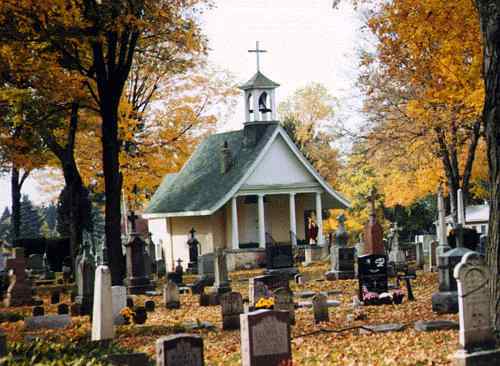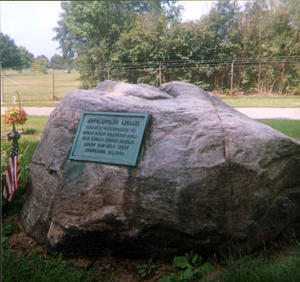
Notre Dame's Grotto / by Dorothy V. Corson


Interesting Descriptions of Early Notre Dame in Indian Times
Numerous interesting excerpts from a variety of sources in the University Archives, verify that Indians -- and Indian Chiefs -- were very much a part of the Notre Dame campus in the early days of its history.
The beautiful Lake [St. Mary's], being only a mile from LaSalle's portage and in the midst of a rich hunting ground, was the central meeting place for the entire region. Here the Indians came to meet the traders, and here the missionaries came, bringing with them the light of God.(189)
An old ledger containing early obituaries recorded this death notice, entered on the 28th of March, 1847, for William Richardville (1846-1847).
This young man, the son of an Indian Chief, of the Miami Tribe was our first student who died. He died of consumption in the old building where the present Infirmary stands in the actual corridor between the students office and the minims wash room. He was buried in the present Parish Graveyard [Cedar Grove Cemetery].(190)
The Scholastic reported: "On July 4, 1848 at commencement exercises, a premium was awarded Thomas La Fontaine, Indian son of the Chief of the Miamis."(191)
Father Sorin described the University of Notre Dame in the 1860s as having the appearance of a most agreeable and romantic little village.(192) When he was considering the question as to when the new Our Lady of the Sacred Heart Church should be dedicated he painted another romantic picture of it and includes "his dear Indians."
What a consolation will it not be to see the dedication of a temple in honor of our Blessed Mother on the spot where we well remember having seen with our own eyes the wigwams and the fires of the Potawatomis! (193)
Howard's History Of St. Joseph County Indiana (194) also paints this picture of what the Notre Dame campus was like when Indians were still a part of it in 1845.
To the right of you, to the left of you, in front of you, and behind you, reigned the primeval forest. There were not thirty acres of clearance in the whole section of land belonging to the college.
In 1876 he recalled these earlier times:
When several of the students were sons of civilized Indian Chiefs or other distinguished braves among the remnants of the tribes yet left in northern Indiana and southern Michigan, even finer sport was found in the weekly excursions, by foot and carryalls and other hired vehicles and winter sleigh rides. Bears, wolves, deer, turkey, coons, opossums, catamounts and prairie hens were found in the pathless woods and prairies, while the lakes and streams were covered with wild geese and other aquatic game. The boys found a bear in a bee tree, trying to rob the honey. The Indian boys soon smoked out the bear, and then made short work of him, much to the amazement of their white companions. They managed also to get the honey which the unfortunate bear had been after.
With the Indians and the bears, such exciting excursions came to an end, but the charms of the weekly tramps continue even to this day. They are, however, of necessity now confined to the grounds of the University and chiefly by the margins of the charming lakes.
Perhaps part of the necessity of confining those excursions to the grounds of the University is explained by this unfortunate hunting accident and the heroic deed associated with it. It occurred on October 7, 1878, six weeks after Father Sorin's 1878 Grotto was dedicated.
We have this week a melancholy duty to perform in announcing the death of Mr. George W. Sampson, who had just entered on his third year as a student at Notre Dame. His death was caused by the accidental discharge of a fowling piece while he was absent with a hunting party. Mr. Sampson was passionately fond of this amusement, and on Monday last, the first extra holiday of the year, he left the College in high spirits with a few other young men to enjoy a day's shooting in the country and at the same time to try a magnificent new breech-loader which had been presented to him during vacation by his father. While on his way back he met his untimely end. Rev. Father O'Sullivan of Laporte who was on the opposite bank of the St. Joseph River at the time the accident occurred, immediately plunged in and swam across -- though risking his own life thereby -- and was present to soothe the unfortunate man's last moments with the consolations of religion. . . . The incident is one of the saddest ever chronicled in the annals of Notre Dame. A young man of bright promise and of the happiest disposition, gentle and amiable towards all, -- to know young Sampson was to be his friend, and we have every reason to hope that the favorable judgment which all who knew him on earth were so ready to pronounce on him has been ratified above. May he rest in peace!(195)
If the sons of Indian Chiefs were students on campus in those early days, were there also Indian Chiefs living on or near the campus who could have passed on the legend to the early religious on campus?
An 1859 guide to the campus indicates that a few Indians who left Kansas and returned to Indiana were cared for by the University.
Here we cross the highway [US 31] leading from South Bend to Niles and find ourselves on the other side of the boundary line separating the college grounds [Notre Dame] from those of St. Mary's Academy. The gate of the Academy is attended by a lone Indian, one of the few remaining in the region. His cottage stands before you as a porter's lodge on the public road. Kindness and charity bestowed this situation, when old age and infirmity were upon him.(196)
Another reference to this practice provides a glimpse of the times and the plight of the displaced Indians:
Among the Indians in the northwestern part of the county was a petty chief named Sagganee, who, when the Indians were removed to the west, went to Kansas with some of them, but soon returned saying that he could not live there because there was no sugar tree. He was a devout Catholic and would never eat anything without first crossing himself. In his later days he was cared for at the Catholic University of Notre Dame, at South Bend, where he passed away, and where his remains lie buried. He is said to have been a great brave in his day and to have fought in the battle of Tippecanoe in 1812.(197)
Local records verify that Chief Sagganee was present in the area and might have been the "Gate House" Indian who lived on campus. He was a chief, an old man in 1859 and fought in the Tippecanoe Battle in 1812, which would definitely put him in the right time frame to be the Indian Chief in the legend.
Two other Indian burials at Notre Dame were also recorded. One Indian named Alexis was buried in 1896. The second one mentioned, Chippa,(198) was also a chief and a possible candidate for the legend:
Brother Frances Xavier buried in Cedar Grove Cemetery, Notre Dame, Chippa, an Indian reputed to be nearly 150 years old. He was one of the few aboriginals remaining in this part of the country and formerly belonged to the tribe of Miamis who lived in the neighborhood of Ft. Wayne.(199)
Although all these Indians were reported to be buried on campus, there were index cards in the burial records only on Chippa and Alexis who died in the 1890s. Nothing could be found at St. Mary's or Notre Dame on the burial of the Indian gatekeeper or Chief Sagganee. However, early burial records at Cedar Grove Cemetery were destroyed in a fire, which might explain their absence.

In 1932, the South Bend Tribune described the reinternment of Indian remains in Cedar Grove Cemetery under the heading: "Mystery Cloaks Indian Burial Grounds." Beside a picture of the marker, on a huge boulder placed over the common grave at Cedar Grove, is this explanation:
Perhaps a tribal chieftain and his warriors are lying beneath this smooth green mound in Cedar Grove Cemetery at Notre Dame. No one could discover the names of these Potawatomis when they were removed from the tiny Indian cemetery at the top of Angela hill in 1928. Their first resting place was hidden in a thicket and marked with a plain iron cross. All identification has been lost in the mystery and silence so peculiar to the race. The graves were transferred to permit widening of Angela boulevard. On the marker are the words:
POTAWATOMI INDIANS --
REMAINS TRANSFERRED TO
CEDAR GROVE CEMETERY FROM
AN INDIAN BURIAL GROUND
ABOUT ONE MILE WEST --
SEPTEMBER 22, 1928.(200)
In the late 1980s, Indian medicine men presided over a big ceremony at Cedar Grove Cemetery (said to be 150 people, with drums). Two skeletons of their ancestors rescued from the museum of the Western Michigan College were buried in the mound. The sexton, Tim Mosier, who was there at the time, said their visit was very quietly accomplished to avoid any publicity and was over before anyone else knew about it.
On February 6, 1875, the Scholastic reported a fourth burial of an Indian Chief, another likely candidate for the legend, "Mr. John Piashway, a one time Chief of the Miamis, was buried here last Wednesday."(201)
Piashway lived in the area where Peashway street is now, directly across from the present golf course at Notre Dame. He was the son of Chief Richardville, also Chief of the Miamis, and married the daughter of another chief, Chief Steven Benneck, who died in 1853 at 75 years of age. His wife's father lived with them on their land across from Notre Dame.
There was no doubt about it, Indians were very much in evidence at Notre Dame from before Badin's time until the Indian removal, and even long afterward. Which means anyone of the aforementioned Indian Chiefs who lived in close proximity to the campus, could have been the Indian Chief who told the story that became the legend.
The time has now come for the reader to decide whether the story behind the fabled sycamore, on the Grotto lawn, is fact or fiction, history or legend. So here's the story and here's what has been learned about it.